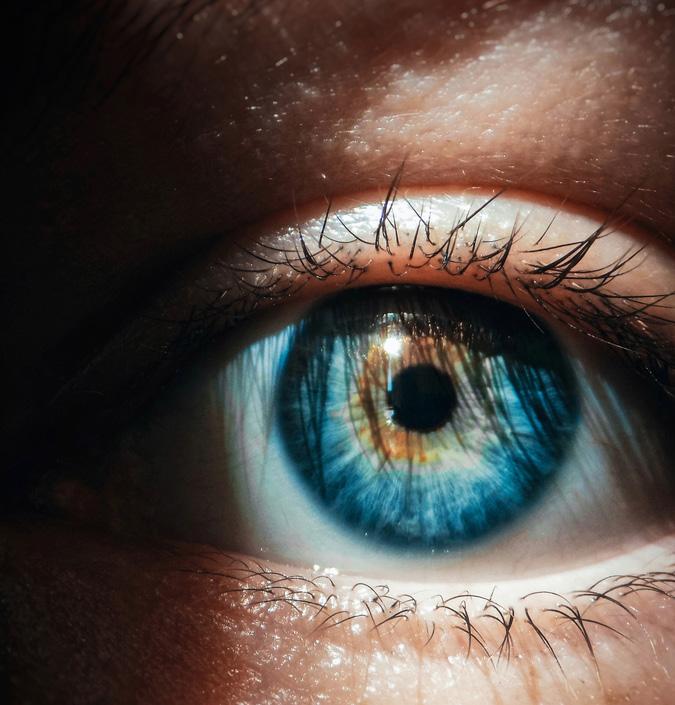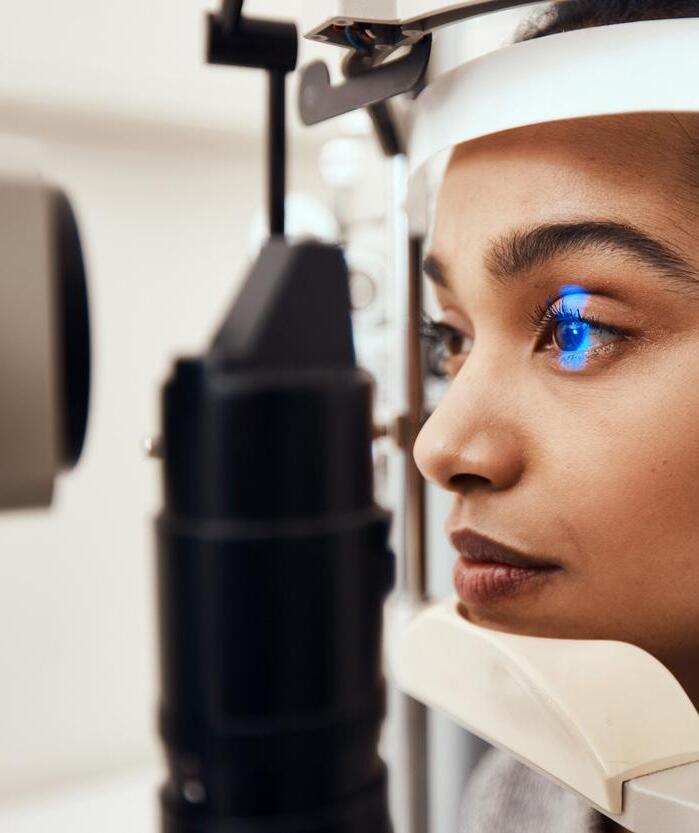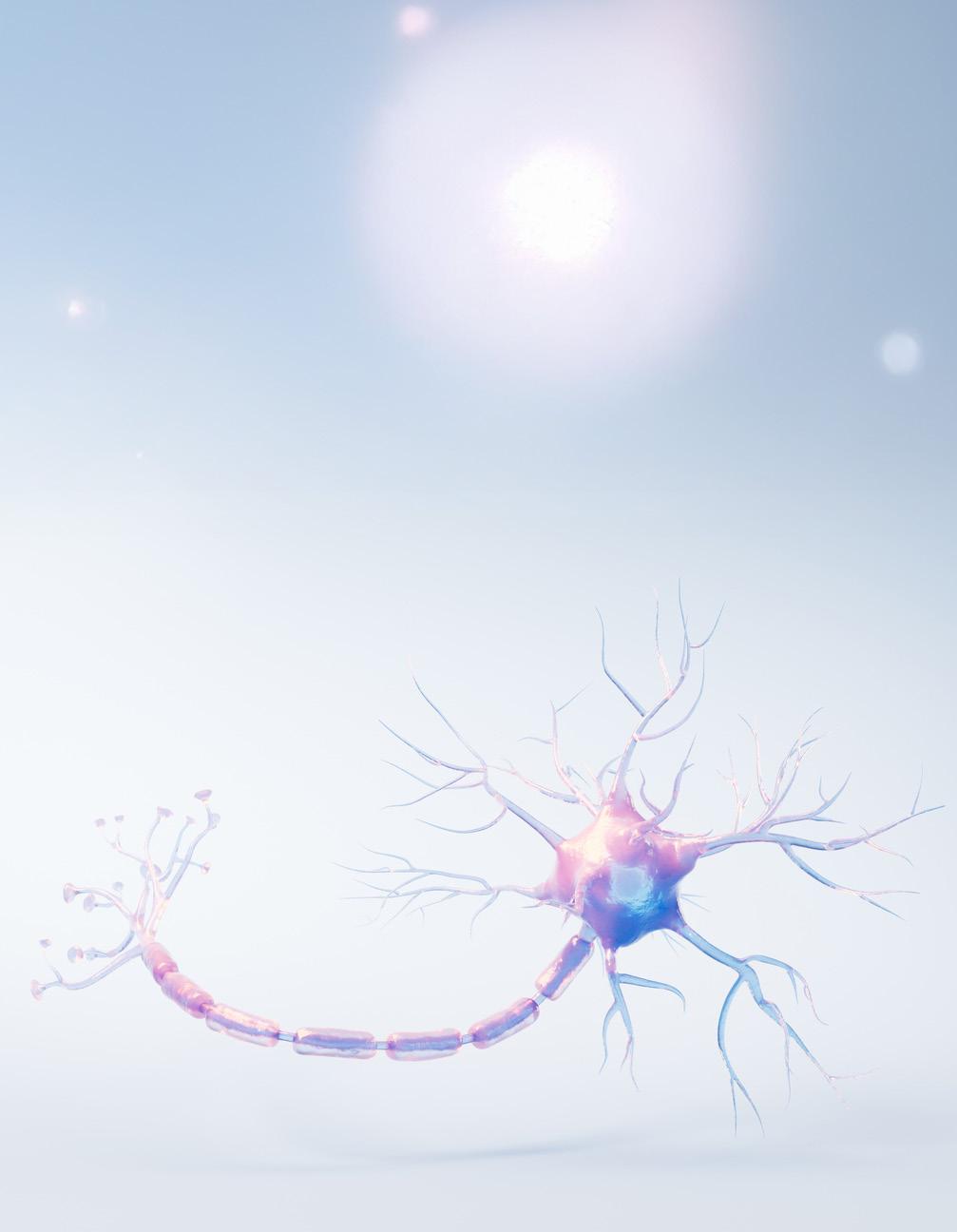

YOUR VISION MATTERS
Maintaining eye health and spotting early warning signs, plus busting migraine myths and self-advocacy tips
Health Your
In this issue of Your Health, we begin by exploring eye health, uncovering the key signs of common conditions, the surprising ways your eyes can reveal insights into your overall health and practical tips for setting up a vision-friendly workspace. We then debunk 10 migraine myths, separating fact from fiction to help you better understand and manage this oftenmisunderstood condition. Finally, we delve into the impact of unconscious bias, offering guidance on recognising and overcoming these hidden barriers while empowering you to advocate for yourself and others.

Your Vision Matters
Vision is one of the five basic senses on which we depend and maintaining good eye health is important. Changes in your vision or discomfort in your eyes can also signal underlying health issues arising elsewhere in the body, so becoming familiar with what good eye health feels like is helpful for selfmonitoring and knowing when to request assessment from your GP or an optician.
This article explores the key signs of common eye conditions, the surprising ways your eyes can reflect your overall health and practical steps to set up a workspace that supports your vision.
RECOGNISING COMMON VISION AND EYE PROBLEMS
Changes in your vision or eye discomfort can indicate a range of common eye problems, some of which may require professional attention. Recognising the signs early means that effective treatment can be sought at an early stage.
f Dry eye syndrome
Dry eye syndrome occurs when your eyes don’t produce enough tears or when the tears evaporate too quickly, leaving your eyes feeling dry and irritated. Common symptoms include a burning or stinging sensation, redness, sensitivity to light and a gritty feeling, as though something is in your eye. Ageing, specific health conditions, medications and environmental factors can all contribute to this condition. The tendency to blink less often when using screens and inappropriately high screens can aggravate symptoms. Often treatment involves lubricating eye drops and modifying your behaviour and environment, for example taking regular breaks from screens and reading, avoiding smoking and air conditioning and using a humidifier to keep the air moist. In certain cases, medication or surgery may be required.
f Digital eye strain
With the increased use of digital devices, eye strain, also known as computer vision syndrome, has emerged. Viewing a screen for long periods can make the eyes work harder for reasons related to contrast, glare, clarity and viewing distance. Uncorrected refractive errors aggravate the issue. Some people experience symptoms like tired eyes, eye discomfort, blurred vision and headaches. You can help alleviate eye strain by wearing the correct glasses, taking regular breaks and setting up your workstation correctly, including adjusting your screen’s brightness, ensuring proper screen positioning and optimising room lighting.
f Refractive errors
Refractive errors, such as myopia (short-sightedness), hyperopia (longsightedness), astigmatism and presbyopia (age-related difficulty focusing on close objects), are among the most common vision problems. These occur when the shape of your eye prevents light from focusing correctly on the retina or due to age related changes in the flexibility of the lens and functioning of tiny muscles controlling its movement. You are likely to have difficulty focusing on distant or near objects, experiencing blurred vision in the affected area, potentially leading to squinting and eye fatigue. An optician can assess this issue. The vast majority of refractive errors can be corrected by glasses or contact lenses. Laser eye surgery is an option for some people.


f Cataracts
Cataracts are a clouding of the eye’s natural lens, which can develop with age or as a result of previous injury, underlying eye or health condition, steroid medication, smoking or high sunlight exposure without protection. The risk is also increased by genetic factors. Symptoms include blurry or cloudy vision, difficulty seeing at night, seeing halos around lights, sensitivity to glare and colours appearing faded. Early-stage cataracts may be managed with stronger glasses or better lighting, but surgery to replace the cloudy lens with an artificial one is the most effective treatment for advanced cases.
Recognising the signs early means that effective treatment can be sought at an early stage.
f Glaucoma
This condition results when increased pressure in the eye causes damage to the optic nerve at the back of the eye, which communicates visual information to the brain. It typically develops slowly without obvious symptoms and is usually picked up during routine eye screening tests. The risk is increased with age, diabetes, if you have a close relative with glaucoma and for people of Black African, Caribbean or Asian descent. If it develops suddenly, you might experience intense eye pain, eye redness, blurred vision, nausea, headache and see rainbowcoloured halos around lights. Glaucoma can result in permanent loss of vision (starting in periphery) if left untreated. You should seek assessment urgently in the event of sudden symptoms and surgery may be required. Other treatment options include prescription eye drops and laser treatment. Ongoing specialist monitoring will be required.


EYES AS INDICATORS OF GENERAL HEALTH
Your eyes are not only vital for vision but also serve as indicators of broader health issues. Many systemic conditions can manifest with symptoms in the eyes, making regular eye tests a key tool for early detection.
f Diabetes
Diabetic retinopathy, a complication of diabetes, occurs when high blood sugar damages the blood vessels in the retina –the light-sensitive layer at the back of the eye. Symptoms may include:
• Blurred or patchy vision
• Sudden vision loss
• Shapes floating in your field of vision (floaters)
• Difficulty seeing in the dark
Regular eye tests can detect early signs of diabetic retinopathy before symptoms occur, and people known to have diabetes are invited for eye screening. It is very important to attend screening appointments, detect and respond to changes early because if left untreated, diabetic retinopathy can cause permanent loss of vision. Good control of sugar levels, blood pressure and cholesterol help to reduce the risk of this condition developing.
f High blood pressure (Hypertension)
Hypertension can also cause damage to the small blood vessels supplying the retina, leading to hypertensive retinopathy. This typically develops over time without symptoms, but you might experience:
• Headaches
• Eye pain
• Blurred vision
• Sudden vision loss (in rare cases)
This can be picked up at an early stage in a routine eye test. Maintaining good control of blood pressure with lifestyle factors and/or medication is important to
prevent onset and reduce progression once established.
f Autoimmune diseases
As well as affecting the joints, conditions like rheumatoid arthritis or lupus can also cause inflammation in parts of the eye (uveitis) and contribute to dry eye syndrome. Symptoms may include:
• Eye redness and pain
• Sensitivity to light
The eye symptoms may improve with treatment of the underlying condition, or require separate eye drops to reduce inflammation and lubricate the eye.
f Neurological conditions
Conditions affecting the brain and nerves connected to the eyes, such as multiple sclerosis, a stroke or a brain tumour can present with visual problems. Symptoms may include:
• Eye pain with movements
• Double vision
• A new squint
• Sudden vision loss
f High cholesterol
High cholesterol increases the risk of heart and blood vessel disease, including stroke. Eye signs include yellowy patches/deposits on or around the eyelids and a whitish ring, visible around the coloured part of the eye. Cholesterol levels can be controlled with lifestyle changes and medication.
WHEN TO SEEK HELP
If you notice a sudden change in your vision or new eye symptoms, you should consult a doctor or an optician without delay. Don’t wait for your next routine eye test. Regular eye tests – recommended every two years by the NHS or more often if at risk – can catch problems early, and protect your sight and overall wellbeing. Most problems are easier to treat and control if picked up at an early stage.

SETTING UP AN EYE-FRIENDLY WORKSPACE
As more of us spend long hours in front of screens, it’s increasingly important to create an environment that supports our eye health. The good news is that with a few thoughtful adjustments, you can set up an eye-friendly workspace to minimise strain and protect your vision.
Position your screen correctly
f Keep your screen at arm’s length (about 50-70cm away).
f The top of the screen should be at or slightly below eye level, allowing your eyes to naturally look downward.
f Position your screen to reduce glare.
Optimise lighting
f Avoid harsh overhead lighting or reflections on your screen.
f Try a desk lamp with adjustable brightness for focused lighting.
f Position your desk perpendicular to windows to reduce glare from natural light.
Adjust screen settings
f Match the screen brightness to your surroundings.
f Use high-contrast settings (e.g., black text on a white background).
Follow the 20-20-20 rule
f Every 20 minutes, look at something 20 feet away for 20 seconds. This helps your eyes relax and reduces strain.
Blink often and stay hydrated
f Prolonged screen use can reduce your blink rate, leading to dry eyes. Try consciously blinking more often and use lubricating eye drops if needed.
By making these adjustments, you can create an environment that promotes eye comfort and productivity.




Busting Migraine Myths
Migraines are a commonly misunderstood health condition, often dismissed as ‘just a bad headache.’ In reality, they are a complex neurological disorder with unique symptoms, triggers and challenges. It is estimated that there are around three million workdays lost every year due to migraine-related absenteeism.
Here we debunk 10 common myths about migraines, helping to clarify the science behind them and the realities faced by those who live with the condition.
MYTH: Migraines are just bad headaches
FACT: Migraines are much more than severe headaches. They are a neurological disorder that can involve a range of symptoms, including nausea, vomiting, sensitivity to light and sound, dizziness, altered sensation and power in limbs, and visual disturbances (aura). While headaches are a common symptom, migraines can significantly impact daily life even without head pain.
MYTH: Migraines only happen to women
FACT: While migraines are more common in women, they can also affect men and children. The lifetime prevalence has been reported as 33% in women and 13% in men, but before puberty, there is no difference between the sexes. Migraine is often linked to fluctuations in hormone levels, particularly oestrogen, which is one of the main reasons why migraines are significantly more common in women than in men.
MYTH: Migraines are all in your head
FACT: Migraines are a physical condition with real, measurable effects on the brain and body. They are understood as a problem with the excitability, or activation, of networks of nerves in the brain. Brain imaging studies have shown changes in blood flow, electrical activity and chemical imbalances during migraines.


MYTH: Migraines are caused by stress alone
FACT: Stress is just one of many potential triggers for migraines. Other triggers include hormonal changes, certain foods, dehydration, lack of sleep, changes in weather and sensory stimuli like bright lights or strong smells. Not all those with migraine can identify triggers, but, where they do, each person’s triggers are unique and migraines are often caused by a combination of factors.
MYTH: Migraines are caused by poor lifestyle choices
FACT: While certain lifestyle factors like diet, hydration and sleep can influence their frequency, migraines are primarily a neurological condition and the underlying cause is not fully understood. It is thought that genetic factors play a role, as migraines often run in families and they are not simply the result of poor habits.
MYTH: Migraines are rare
FACT: Migraines are far from rare and are one of the most common neurological conditions worldwide. According to the World Health Organization (WHO), migraines affect about 1 in 7 people globally.
MYTH: Migraines permanently damage the brain
FACT: While migraines are disruptive and can cause temporary changes in brain function, they do not result in permanent brain damage. There is some evidence that having migraines slightly increases the risk of having a stroke, but it is not thought that migraines cause strokes.
MYTH: You can ‘push through’ a migraine
FACT: Migraines are not something you can always power through. The severity of symptoms often requires rest, quiet, low lighting and usually medication to manage. Ignoring a migraine can prolong its duration, making recovery even more difficult.
Migraines are a physical condition with real, measurable effects on the brain and body
MYTH: Migraines only last a few hours and then you’re fine
Migraines can last anywhere from 4 hours to 72 hours or more if untreated. They often occur in phases: the prodrome (early warning signs like fatigue or mood changes), the aura (in some people, like visual changes), the headache phase (intense pain, often onesided) and the postdrome (feeling drained or ‘hungover’ after the attack). Recovery can take days for some individuals.
MYTH: Migraines only affect the brain
FACT: Migraines are a whole-body experience. In addition to head pain, neurological symptoms, and sometimes psychological impact, they can cause fatigue, nausea, digestive issues and muscle tension.


Advocating for Yourself and Others
RECOGNISING AND OVERCOMING UNCONSCIOUS BIAS
Unconscious biases are automatic judgments and decisions we make based on stereotypes, assumptions or prior experiences. These biases, while often unintentional, can create barriers to inclusion and opportunity in the workplace, particularly for our neurodivergent colleagues. For individuals with neurodivergences such as autism, ADHD or dyslexia, unconscious bias can prevent their unique strengths from being recognised and supported.
To foster a truly inclusive and neuroaffirming workplace, it is essential to educate employers to recognise and address unconscious bias, and empower neurodivergent employees to advocate for themselves effectively.
UNDERSTANDING UNCONSCIOUS BIAS IN NEURODIVERSITY
Unconscious bias often stems from preconceived notions about neurodivergence, shaped by, for example, stereotypes in the media or past experiences with neurodivergent individuals. These biases can lead to assumptions about how neurodivergent employees think, communicate or process information, often treating them as a monolithic group rather than recognising their individual experiences. The result can be misunderstandings about their strengths and differences, which may hinder their ability to thrive in the workplace.


SELF-ADVOCACY: EMPOWERING NEURODIVERGENT EMPLOYEES
For neurodivergent employees, selfadvocacy is a powerful tool for fostering wellbeing and creating a positive work environment. However, it can be challenging due to fears of judgment or exclusion.
empower neurodivergent employees to advocate for themselves effectively
Here are practical strategies for effective self-advocacy:
f Understand available support
Familiarise yourself with the support systems and workplace resources accessible to you. For instance, access to your organisation’s neurodiversity network or workplace needs assessments to identify reasonable adjustments. It is important to note that such adjustments do not require formal diagnosis under the Equality Act.
f Use clear and positive language
Frame your neurodivergence as a source of unique strengths. Focus on what you can do, how you can thrive, and what the workplace can do to set you up for sucess.
f Leverage communication tools
Tools like a ‘Manual of Me’ or workplace passports can help articulate and discuss your needs and preferences during discussions with employers.
EMPLOYER SUPPORT: FOSTERING AN INCLUSIVE ENVIRONMENT
While self-advocacy is crucial, employers play an equally vital role in creating an environment where neurodivergent employees feel supported and empowered.
educate employers to recognise and address unconscious bias
Proactive strategies to overcome unconscious bias and create an environment for self-advocacy include the following:
f Implement neurodiversity training
Provide training that encourages judgement free discussions and draws on insights from neurodiversity networks.
f Foster open communication
Engage directly with neurodivergent employees to understand their unique perspectives and working styles.
f Create flexible work policies
Encourage all employees, regardless of neurotype, to share their working needs and preferences, and accommodate these where viable.
f Promote allyship
Lead by example to cultivate a culture of understanding and inclusion within teams.
MOVING FORWARD: BUILDING A NEUROAFFIRMING WORKPLACE
Overcoming unconscious bias requires a collaborative effort between employees and employers. Neurodivergent employees must feel empowered to advocate for their needs, while employers must actively work to understand and accommodate them. By addressing unconscious bias and fostering open communication, organisations can create a more inclusive and positive workplace for all, where diverse talents and perspectives are celebrated.

RESOURCES
f Eye Conditions and Diseases | National Eye Institute
f Eye Health and Conditions | Specsavers UK
f Eye Diseases: Types, Symptoms, Causes & Treatment Options
f Your eyes - find information on sight and conditions | RNIB
f How often can I have a free NHS sight test? | NHS
f What is migraine? | The Migraine Trust
f Migraine | NHS
f Migraine | Symptoms and causes - Mayo Clinic
f Migraine: What It Is, Types, Causes, Symptoms & Treatments
f Prevalence | Background information | Migraine | CKS | NICE
f Migraine and hormones | The Migraine Trust


NEXT ISSUE:
f ADHD Awareness
f Menopause
f Stoptober & Lung Health
At Health Partners we offer a full range of tailored health and wellbeing services.
Our thinking is innovative. We constantly develop new responses and tools designed to address the health and wellbeing challenges that face your business and people.
Our commitment is total. We invest in our services, creating new ones and keeping in step with every client. We constantly explore new ways of working and make no compromises in the quality of our services.
Simply put, we are here to help people be their best.
